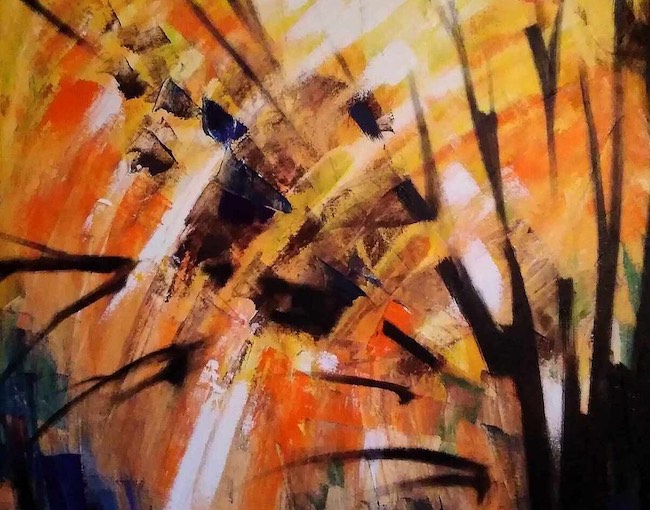Osservando le opere di alcuni artisti appartenenti al panorama contemporaneo, non si può fare a meno di notare quanto sia evidente la necessità di plasmare i passaggi compiuti nelle innovazioni del secolo scorso per adattarli a uno stile più personale dove la parola d’ordine sia l’autonomia, il rifiuto di lasciar arginare la creatività per attenersi a regole che diventerebbero limitanti per la vivacità espressiva dell’attualità. Sia che gli artisti scelgano un approccio più figurativo sia che si avvicinino invece a tutto quel mondo informale dove le parole e i pensieri vengono affidati ai colori, l’adeguamento alle proprie inclinazioni creative è essenziale per gli autori contemporanei perché solo così riescono ad armonizzare le innovazioni del passato a un mondo moderno dove tutto si è modificato, e di conseguenza anche il modo di affrontare e riflettere sulla realtà. La protagonista di oggi infonde nelle sue opere un senso di affrancamento da qualsiasi delimitazione, perché lo sguardo che lascia vagare sulla natura circostante, o sulle sensazioni legate a un particolare pensiero o punto di vista, è totalmente assoggettato alle proprie emozioni, al suo modo quasi melodico di guardare ciò che la circonda.
A seguito del completo distacco dal mondo emozionale che fu necessario per determinare la rivoluzione avanguardistica che interessò il mondo dell’arte figurativa dei primi anni del Novecento, intendo quindi tutti quei movimenti che eliminarono i riferimenti figurativi per sottolineare quanto l’arte fosse irriproducibile e superiore alle nuove tecnologie emergenti come la fotografia, emerse la consapevolezza che in mancanza di emozione ogni rappresentazione figurativa perdeva il senso di coinvolgimento appartenente all’arte. Dunque le iniziali teorie di Wassily Kandinsky, padre dell’Astrattismo, sull’interazione tra sensazione e pittura, vennero riprese e persino ampliate intorno agli anni Cinquanta del Novecento da un movimento nato di fatto negli Stati Uniti ma che riuniva molti artisti costretti a fuggire dall’Europa a causa della seconda guerra mondiale, e che apportarono le loro teorie sulla manifestazione creativa fino a trasformarle nelle linee guida dell’Espressionismo Astratto. Mancanza di regole, possibilità per ciascun autore di creare lo stile più affine alla propria interiorità, autonomia nell’avvicinarsi alla lieve figurazione o all’informale più ermetico fino a giungere alla totale monocromia, tutto era accettato purché all’interno delle tele fosse manifestata l’emozionalità dell’esecutore dell’opera. Questo movimento fu talmente liberatorio che cominciò velocemente a diffondersi anche nel Vecchio Continente, trovando nel tedesco Gerard Richter, attualmente uno dei più quotati artisti viventi, forse il maggior interprete, quello più in grado di declinare e plasmare i colori come fossero frammenti di pensieri o di sensazioni e armonizzandoli con ciò che prova nel momento in cui si appresta a dipingere; una delle sue caratteristiche più riconoscibili è lo Squeegee Painting, letteralmente la raschiatura attraverso l’utilizzo di spatole delle linee precedentemente create con il colore. L’impatto delle opere di Richter è forte proprio in virtù di questo nascondere e al tempo stesso raccontare in modo differente tutto ciò che appartiene alla sua interiorità, al suo punto di vista. L’artista lettone Inita Sabanska sceglie l’Espressionismo Astratto per manifestare non solo la sua necessità di narrare tutto ciò che la sua sensibilità coglie, ma anche per lasciar trasparire le sensazione di libertà che lei stessa prova nell’atto del dipingere; i colori divengono lirica poetica così come la raschiatura diventa un modo per enfatizzare le tonalità scelte e necessarie a definire il concetto, o il ricordo, che desidera rappresentare sulla tela.
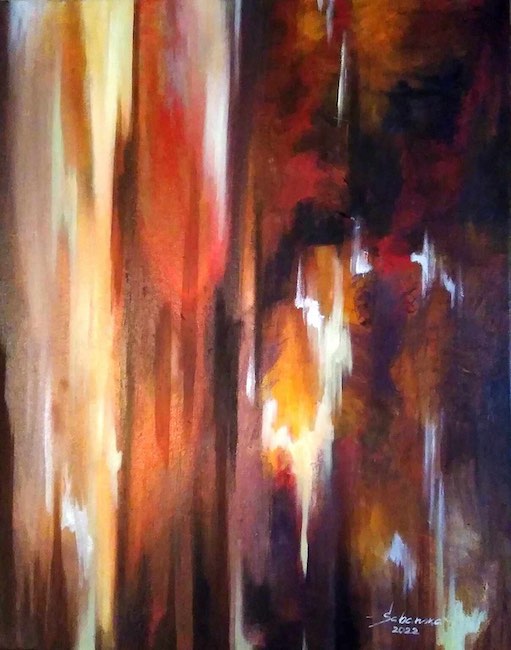
Guardando le opere della Sabanska si ha la stessa sensazione di musicalità che si riceveva osservando le tele di Kandinsky, come se in qualche modo i colori fossero note che si sono impresse sulla superficie bianca per infonderle la forza di un’emozione o di un concetto; l’occhio viene ingannato poiché in alcuni dipinti si illude di trovarsi di fronte a un panorama conosciuto, mentre poi avvicinandosi si perde nell’indefinitezza che però non cela la sensazione visiva ricevuta a distanza anzi, in realtà è proprio quella mancanza di forma a rendere persino più intensa l’armonia cromatica che appartiene al luogo evocato.
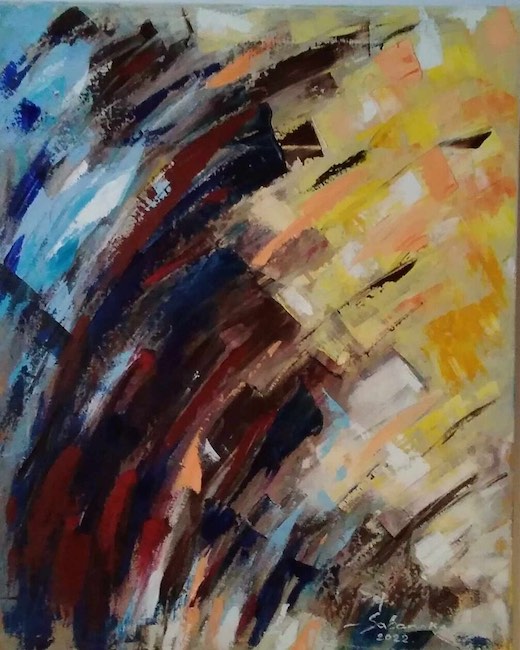
Le tonalità predominanti sono quelle dei rossi, degli arancio, dei blu, più intensi o più tenui sulla base dell’intenzione pittorica di Inita Sabanska, del frammento di ricordo o di riflessione che intende rendere protagonista, ma ciò che più colpisce è quella forte impronta sovrapposta, quelle raschiature spatolate che suscitano il senso del costante movimento della realtà oggettiva ma anche del pensiero in perpetua evoluzione, e che sembrano canalizzare l’attenzione sul quel soffio energetico sottile che appartiene al mondo intorno e che ha il sapore della libertà. Idee, riflessioni, fasi della vita, semplici istanti piacevoli dell’esistenza, sono questi i temi delle opere che Inita Sabanska interpreta a volte con intensità, altre con delicatezza, perché, sembra dire, tutto si concentra e si definisce nell’istante in cui l’emozione si apre e giunge alla coscienza.
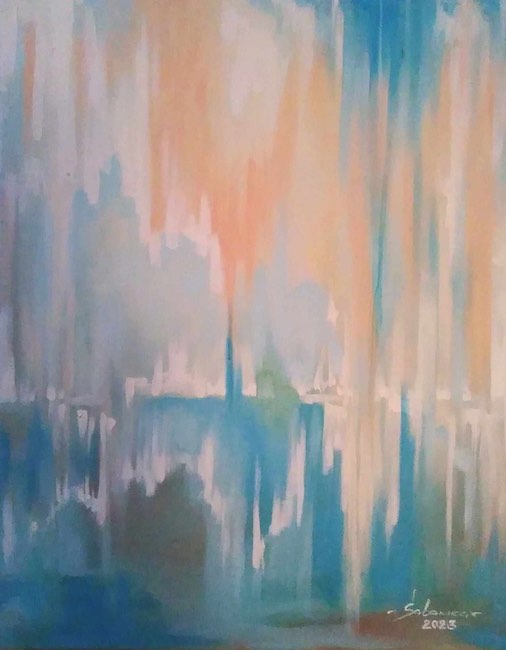
L’opera Sonetto manifesta tutto l’incanto percepito dall’artista nel momento in cui ascolta le magiche note musicali di una melodia classica, tutta la magia che si diffonde intorno e che non può fare a meno di raggiungere le corde interiori che vibrano in virtù del bello, dell’armonia irrazionale eppure tangibile del contatto con la musica; la gamma cromatica è delicata, i colori sono tenui perché lo stato d’animo generato da quel momento idilliaco è di totale coinvolgimento al punto di allontanare ogni tipo di pensiero. I celesti e gli arancioni qui sono chiarissimi, impalpabili proprio perché l’armonia riesce a elevare l’anima verso una dimensione parallela in cui tutto è più leggero, meno concreto certo, ma non per questo meno reale; le striature della pittura sottolineano esattamente quel senso di leggerezza che spinge verso l’alto, verso un livello di purezza inconsapevole che si genera ogni volta in cui la razionalità lascia spazio alla sensibilità, all’emozione.

In Breakout invece le tonalità sono più intense perché Inita Sabanska desidera mettere in luce la sensazione di inquietudine di un’interiorità che ha bisogno di evadere, di trovare un luogo, che sia fisico o spirituale non importa, dove potersi ricaricare, dove riuscire a manifestare in maniera più piena e libera la propria vera essenza. In questo caso le striature e le linee sono tracciate con il pennello sopra alla raschiatura, come se l’artista avesse bisogno di enfatizzare la sensazione di movimento, sottolineata dal colore arancio, che inevitabilmente è necessario compiere quando non si può resistere all’esigenza di andare oltre, di non limitarsi a ciò che sembra appartenere ormai alla quotidianità, al destino, e di rompere gli schemi per ottenere qualcosa di migliore.
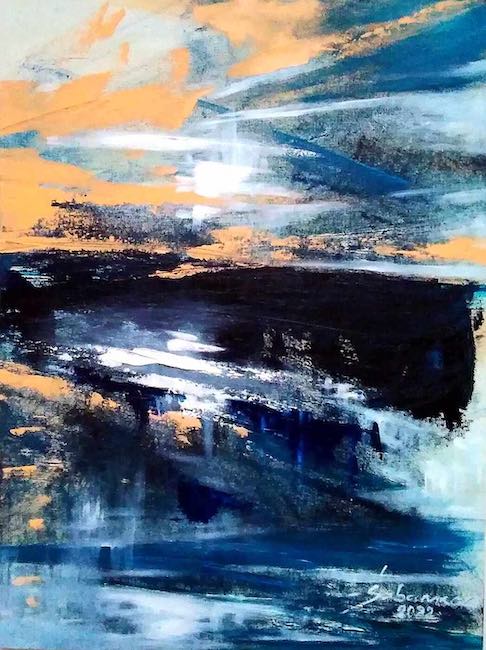
Nel momento in cui la Sabanska si appresta a raccontare scorci di paesaggi ammirati, o angoli di natura che hanno avvolto la sua sensibilità allora l’apparenza si modifica, sembra emergere quella sottile e ingannevole figurazione che di fatto non c’è, perché la non forma è funzionale a condurre l’osservatore verso le sue profondità emozionali, dentro quella poesia interiore non più abituata a fuoriuscire e a farsi sentire; in questa serie di opere la gamma cromatica è quella affine alla realtà, come fosse proprio in virtù dei colori scelti che divenga possibile evocare un frammento di ricordo, un istante di vita che coinvolge il fruitore proprio perché richiama alla coscienza un’immagine conosciuta.
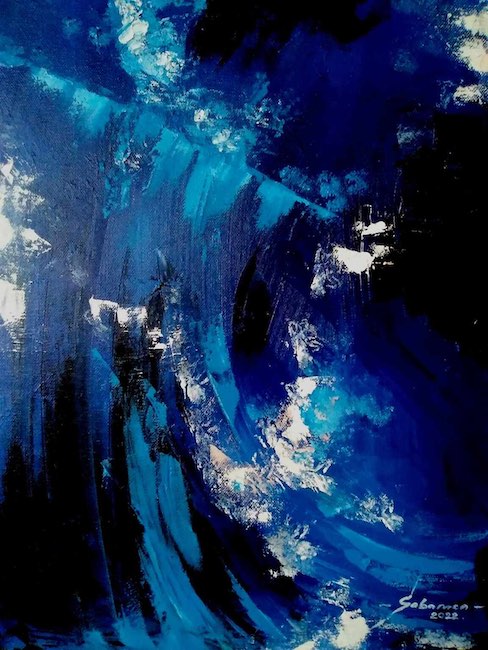
Dunque la tela Nelle profondità dell’oceano è contraddistinta dalla predominanza del colore blu, quello più intenso e scuro che appartiene ai fondali marini dove la luce non riesce a filtrare; all’interno di quella dimensione silenziosa, l’essere umano riesce ad ascoltare il suono della sua interiorità, quasi la suggestione visiva fosse un invito da parte di Inita Sabanska a compiere quel percorso di introspezione necessario a comprendersi e a conoscere meglio se stessi. La sensazione di trovarsi davvero davanti a un’immagine dell’oceano è tanto reale quanto lo è la coscienza successiva di un’indefinitezza che appartiene non solo al dipinto bensì anche alle molteplici sfaccettature del sentire interiore, inconoscibile nella sua totalità e dunque necessitante di costanti approfondimenti e connessioni con il lato emozionale.
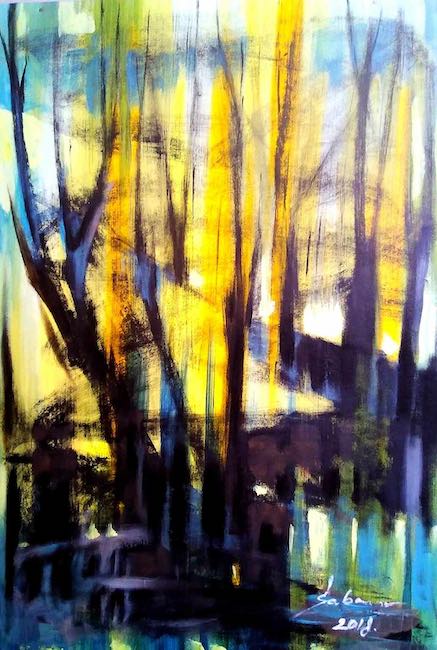
Inita Sabanksa espone dal 1992, anno in cui ha organizzato in Lettonia la sua prima mostra personale; da quel momento in avanti ha partecipato a collettive e concorsi internazionali di pittura in Lussemburgo, Francia, Italia, Stati Uniti, Hong Kong e Germania, vincendo numerosi premi e riconoscimenti per il suo stile inconfondibile.
INITA SABANSKA-CONTATTI
Email: inita.sabanska@inbox.lv
Sito web: www.initasabanska.mozello.lv/
Facebook: www.facebook.com/profile.php?id=100010697949083
The breath of freedom in the artworks between poetry and nature by Inita Sabanska, when Abstract Expressionism takes on infinite nuances
Observing the works of some artists belonging to the contemporary scene, one cannot help but notice how evident is the need to mould the steps taken in the innovations of the last century in order to adapt them to a more personal style where the watchword is autonomy, the refusal to let creativity be curbed in order to abide by rules that would become limiting to the expressive vivacity of the present day. Whether artists choose a more figurative approach or instead approach the whole informal world where words and thoughts are entrusted to colours, adapting to their creative inclinations is essential for contemporary authors because this is the only way they can harmonise the innovations of the past with a modern world where everything has changed, and consequently also the way of facing and reflecting on reality. Today’s protagonist infuses her artworks with a sense of detachment from any delimitation, because the gaze she allows to wander over the surrounding nature, or over the sensations linked to a particular thought or point of view, is totally subject to her emotions, to her almost melodic way of looking at her surroundings.
Following the complete detachment from the emotional world that was necessary to bring about the avant-garde revolution that affected the world of figurative art in the early 20th century, by which I mean all those movements that eliminated figurative references in order to emphasise how art was irreproducible and superior to the new emerging technologies such as photography, emerged an awareness that in the absence of emotion, every figurative representation lost the sense of involvement that belonged to art. Thus, the initial theories of Wassily Kandinsky, the father of Abstractionism, on the interaction between sensation and painting, were taken up and even expanded around the 1950s by a movement that actually originated in the United States but joned together many artists who had been forced to flee Europe due to the Second World War, and who brought their theories on creative manifestation to become the guidelines of Abstract Expressionism. Lack of rules, the possibility for each author to create the style most akin to his interiority, autonomy in approaching light figuration or the most hermetic informal up to total monochrome, everything was accepted as long as the emotionality of the work’s executor was manifested within the canvases.
This movement was so liberating that it quickly began to spread also in the Old Continent, finding in the German artist Gerard Richter, currently one of the most quoted living artists, perhaps the greatest interpreter, the one most capable of declining and shaping colours as if they were fragments of thoughts or sensations and harmonising them with what he feels in the moment he is about to paint; one of his most recognisable characteristics is Squeegee Painting, literally the scraping through the use of spatulas of the lines previously created with colour. The impact of Richter‘s artworks is strong precisely by virtue of this hiding and at the same time telling in a different way everything that belongs to his interiority, his point of view. The Latvian artist Inita Sabanska chooses Abstract Expressionism to manifest not only her need to narrate everything that her sensitivity grasps, but also to allow the sensation of freedom that she herself feels in the act of painting to shine through; the colours become poetic lyricism just as the scraping becomes a way of emphasising the tones chosen and necessary to define the concept, or the memory, that she wishes to represent on canvas. When looking at Sabanska‘s paintings, one has the same feeling of musicality that one received when looking at Kandinsky‘s canvases, as if somehow the colours were notes that were imprinted on the white surface to infuse it with the force of an emotion or a concept; the eye is deceived as in some paintings it deludes itself into thinking that it is in front of a familiar landscape, whereas as it gets closer it loses itself in the indefiniteness that does not, however, conceal the visual sensation received at a distance; in fact, it is precisely that lack of form that makes the chromatic harmony belonging to the evoked place even more intense. The predominant tones are those of reds, oranges and blues, more intense or softer depending on Inita Sabanska‘s pictorial intention, on the fragment of memory or reflection that she intends to make the protagonist, but what is most striking is that strong superimposed imprint, those spatulate scrapings that arouse the sense of the constant movement of objective reality but also of thought in perpetual evolution, and that seem to channel attention to that subtle energy breath that belongs to the world around us and that has the flavour of freedom. Ideas, reflections, phases of life, simple pleasurable moments of existence, these are the themes of the artworks that Inita Sabanska interprets at times with intensity, at others with delicacy, because, she seems to say, everything is concentrated and defined in the instant when emotion opens up and reaches consciousness.
The artwork Sonetto manifests all the enchantment perceived by the artist at the moment she hears the magical musical notes of a classical melody, all the magic that spreads around and cannot help but reach the inner chords that vibrate by virtue of beauty, of the irrational yet tangible harmony of contact with music; the chromatic range is delicate, the colours are soft because the mood generated by that idyllic moment is one of total involvement to the point of banishing all thought. The light blues and oranges here are very clear, impalpable precisely because the harmony manages to elevate the soul towards a parallel dimension in which everything is lighter, less concrete of course, but no less real; the streaks of paint emphasise exactly that sense of lightness that pushes upwards, towards a level of unconscious purity that is generated every time rationality leaves room for sensitivity, for emotion. In Breakout, on the other hand, the tones are more intense because Inita Sabanska wishes to highlight the feeling of restlessness of an interiority that needs to escape, to find a place, whether physical or spiritual does not matter, where one can recharge oneself, where one can manifest one’s true essence more fully and freely. In this case, the streaks and lines are traced with the brush above the scraping, as if the artist needed to emphasise the sensation of movement, underlined by the orange colour, that one inevitably has to make when one cannot resist the need to go further, to not limit oneself to what now seems to belong to everyday life, to destiny, and to break the mould in order to achieve something better.
At the moment when Sabanska is about to narrate glimpses of admired landscapes, or corners of nature that have enveloped her sensibility, then appearance is modified, that subtle and deceptive figuration seems to emerge, which in fact is not there, because the non-form is functional in leading the observer towards her emotional depths, inside that inner poetry that is no longer used to coming out and making itself felt; in this series of works, the chromatic range is one akin to reality, as if it were precisely by virtue of the colours chosen that it becomes possible to evoke a fragment of memory, an instant of life that involves the viewer precisely because it recalls a known image to consciousness. Thus, the canvas In the Depths of the Ocean is characterised by the predominance of blue, the most intense and dark colour that belongs to the seabed where light cannot filter through; within that silent dimension, the human being is able to listen to the sound of his interiority, almost as if the visual suggestion were an invitation by Inita Sabanska to undertake that path of introspection necessary to understand and know oneself better. The sensation of really being in front of an image of the ocean is as real as the subsequent awareness of an indefiniteness that belongs not only to the painting but also to the multiple facets of inner feeling, unknowable in its totality and therefore in need of constant deepening and connections with the emotional side. Inita Sabanksa has been exhibiting since 1992, the year she held her first solo exhibition in Latvia. Since then, she has participated in group exhibitions and international painting competitions in Luxembourg, France, Italy, the United States, Hong Kong and Germany, winning numerous prizes and awards for her unmistakable style.


